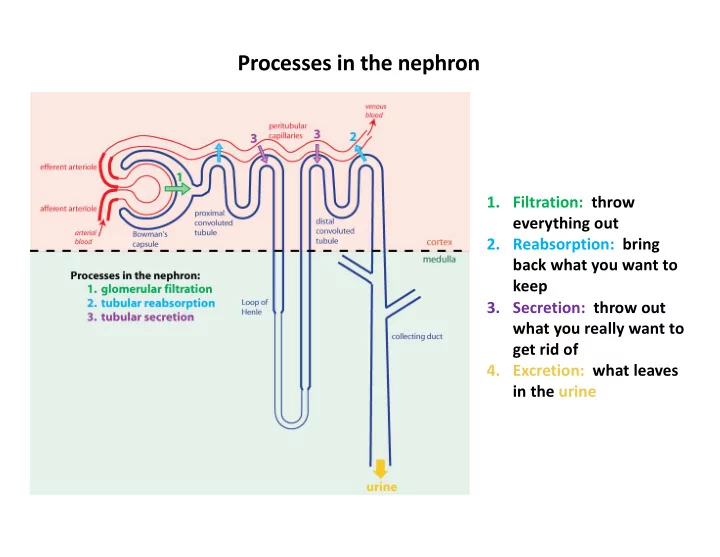

Processes in the nephron 1. Filtration: throw everything out 2. Reabsorption: bring back what you want to keep 3. Secretion: throw out what you really want to get rid of 4. Excretion: what leaves in the urine
Water balance involves the homeostatic regulation of ECF osmolarity
Osmosis and osmotic pressure Figure 5.2 p. 125
Water reabsorption involves the loops of Henle and the collecting ducts in the medulla
Formation of osmotic gradient by the loop of Henle NOTE: don’t worry about details; just know that the loop of Henle is the part of the nephron responsible for generating the osmotic gradient
Regulated water permeability in the collecting duct
Vasopressin also known as antidiuretic hormone (ADH) • hormone released at the posterior pituitary • released by neurosecretory cells • hormone release regulated by osmoreceptors located in • hypothalamus
Neurosecretory cell neurosecretory cells have their cell bodies located in the hypothalamus •
Hypothalamus and pituitary Vander’s Physiology 12 th edition, Fig. 11-13a
Neurosecretory cells of the hypothalamus anterior pituitary posterior pituitary Vander’s Physiology 12 th edition, Fig. 11-13b
Vasopressin regulates water permeability by increasing aquaporins (AQP2) in the apical plasma membrane of the collecting duct
Collecting duct collecting ducts near papilla the collecting duct is lined with a crisp, clear, cuboidal epithelium
Patient D What is the term for excessive urine production? Why does hyperglycemia in diabetes mellitus cause increased urine production? What sensors are responsible for promoting thirst?
Saturation of sodium-glucose cotransporters in the kidney tubules leads to polyuria
Patient D: Test Results
Osmolarity: solute/liter of water Osmolality: solute/kilogram of water
Diabetes insipidus: polyuria due to a defect in the ability to reabsorb water and concentrate urine central diabetes insipidus: deficiency of vasopressin nephrogenic diabetes insipidus: kidney doesn � t respond to vasopressin
What type of cell releases vasopressin? Where are the cell bodies of vasopressin-secreting cells located? What sensors regulate vasopressin release, and where are they located?
Patient D Diagnosis: adipsic diabetes insipidus due to tumor in the hypothalamus Treatment: vasopressin agonist; guidelines for fluid intake
Patient E What does a diuretic do? What specific part of the nephron is damaged to cause proteinuria?
Filtration Occurs in the Renal Corpuscle Figure 19.5 p. 596
Filtration membrane schematic of a cross-section schematic cross-section through two capillary loops through filtration of the glomerulus membrane, highly magnified Figure 19.5c, d; p.596
Proteinuria: sign of damage to the filtration membrane Barriers to filtration of protein: 1. negative charge in glycocalyx 2. meshwork of proteins in glomerular basement membrane 3. meshwork of proteins in the slit diaphragm
serum creatinine metabolism of excretion in the creatine from urine skeletal muscle Does the patient’s increasing serum creatinine indicated that her kidney function is deteriorating or improving?
Diabetic Nephropathy leading cause of end-stage renal disease (end stage renal disease is • kidney function so low it requires renal replacement: either dialysis or kidney transplant) hyperglycemia and/or decreased insulin signaling cause changes to • the glomerulus to cause leaky filtration barrier and proteinuria proteinuria damages nephrons and leads to nephron loss •
Incidence of ESRD by primary diagnosis Data from 1980-2012 From US Renal Data System 2014 Report http://www.usrds.org/2014/view/Default.aspx Data from 1996-2014 From US Renal Data System 2016 Report http://www.usrds.org/2016/view/Default.aspx
Glomerular filtration rate (GFR) rate of fluid flow into Bowman’s space • important measure of kidney function •
Renal Clearance
Processes in the nephron 1. Filtration: throw everything out 2. Reabsorption: bring back what you want to keep 3. Secretion: throw out what you really want to get rid of 4. Excretion: what leaves in the urine
Inulin don’t confuse with insulin • plant carbohydrate (must be injected) • freely filtered • neither reabsorbed nor secreted •
Filtered Load filtered load = amount filtered • filtration: bulk flow of plasma and • all small substances dissolved in it
Recommend
More recommend